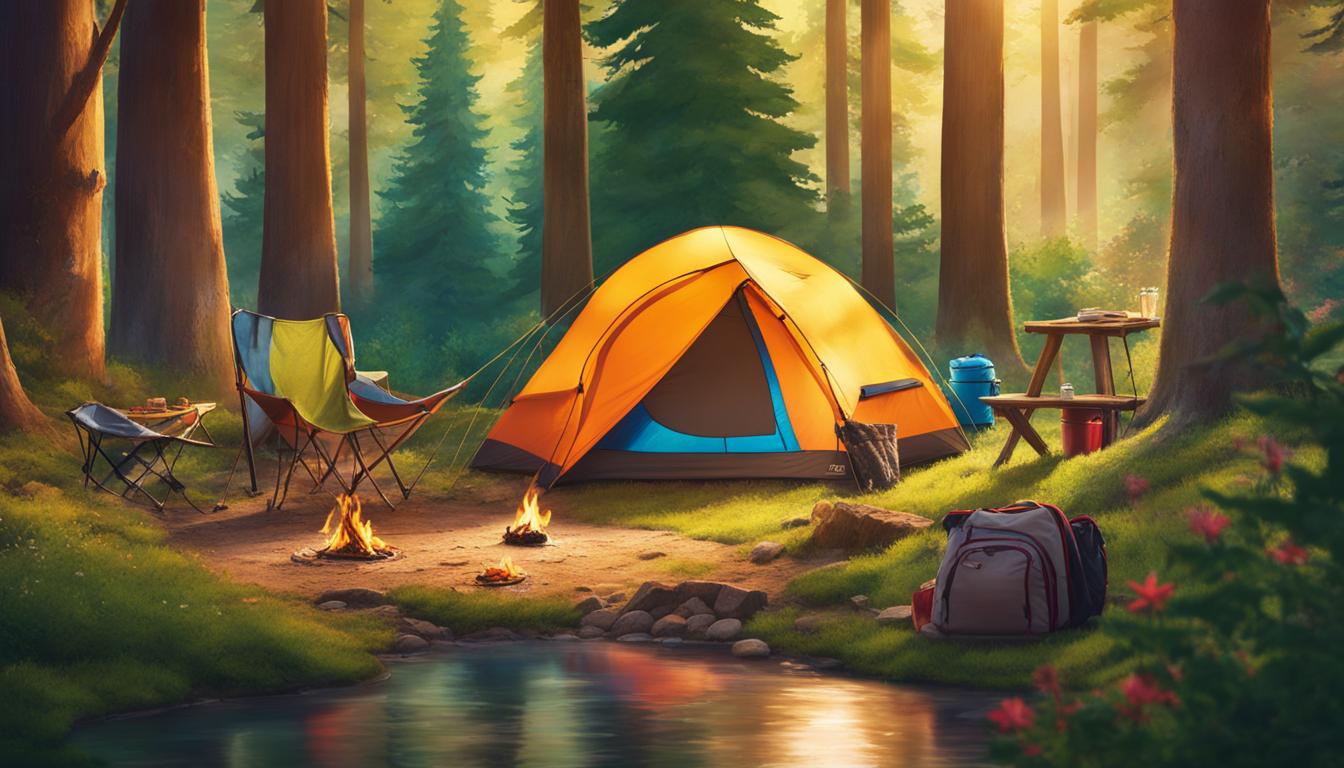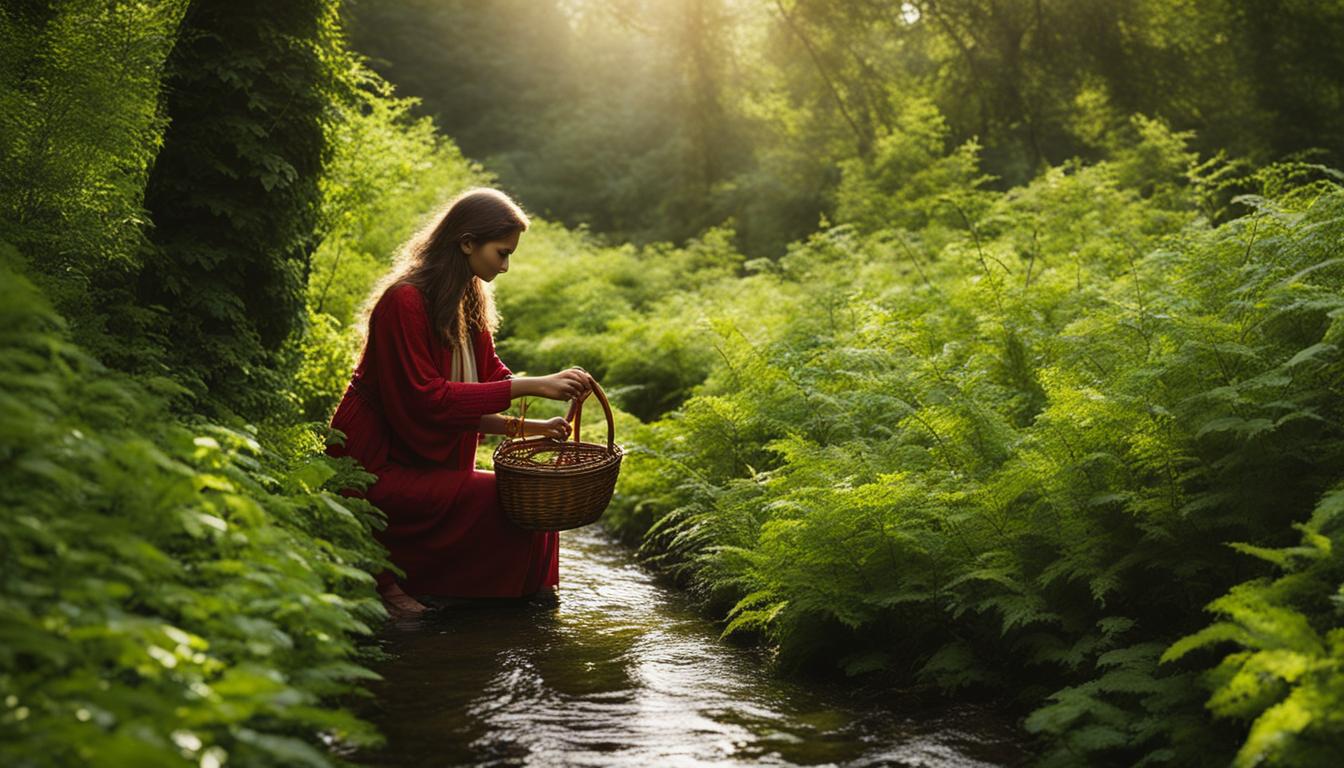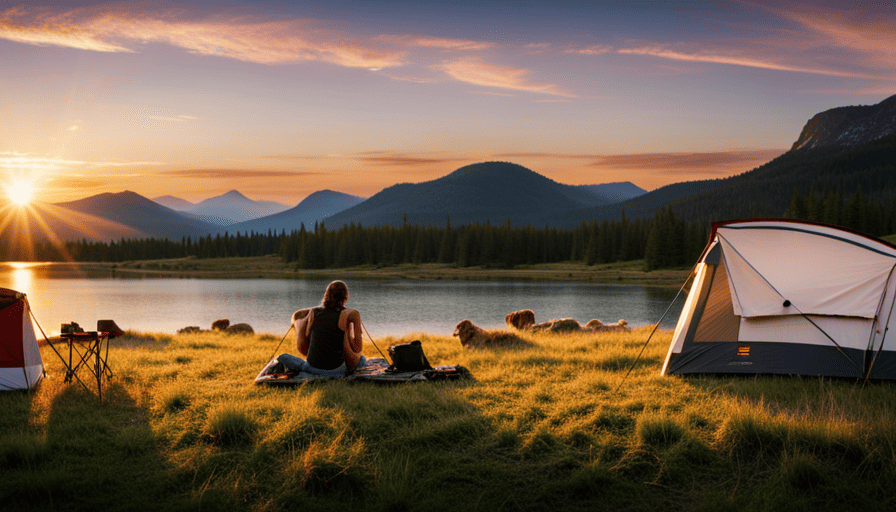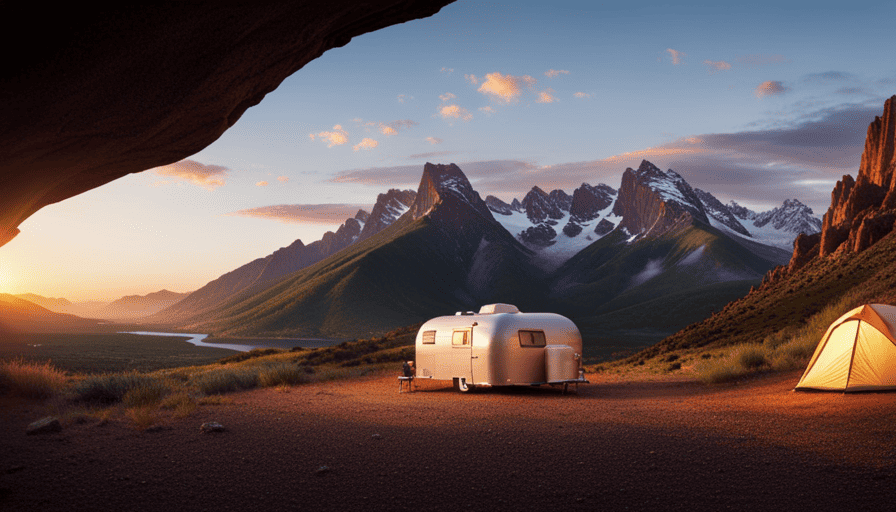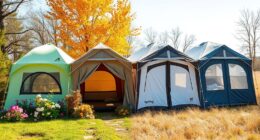If you are new to camping and looking to explore the great outdoors, this comprehensive guide is perfect for you. We will walk you through everything you need to know from setting up your tent to cooking over a campfire, selecting the best campsite, essential gear and supplies, outdoor activities, camping safety, and more. Let’s get started on this exciting camping journey together!
Are you ready to explore the great outdoors and experience the thrill of camping? With our beginner’s guide, you’ll learn all the necessary skills and tips to make your camping trip a success. From building a campfire to choosing the perfect campsite, we’ve got you covered. So, grab your gear, prepare for an adventure, and let’s get started! Don’t forget to pack your backpack with all the backyard camping essentials, such as a sturdy tent, sleeping bag, and portable stove. It’s also important to bring along some insect repellent, a first aid kit, and plenty of water to stay hydrated. With the right preparation and mindset, you’ll be on your way to creating unforgettable memories in the great outdoors. So, get ready to embrace nature and enjoy the simplicity of camping!
Key Takeaways:
- Gather firewood: Tinder, kindling, and fuelwood are essential for a successful campfire.
- Choose the right campfire spot: Ensure it’s flat, away from flammable vegetation, and at a safe distance from tents.
- Build a campfire: Start with tinder, add kindling, and arrange fuelwood in a teepee structure for a lasting fire.
- Take care of your campfire: Monitor the fire, add firewood as needed, and prioritize safety at all times.
- Extinguish your campfire properly: Sprinkle water gradually, stir the ashes, and ensure it’s cool to the touch before leaving.
The Importance of Firewood: A Guide for Beginners
Gathering the right type of firewood is crucial for a successful campfire. When camping, you’ll need three types of firewood – tinder, kindling, and fuelwood. Tinder consists of small, dry materials such as twigs, leaves, or newspaper that easily catch fire. Kindling is slightly larger than tinder and helps sustain the fire once it starts. Fuelwood is the main firewood that provides a long-lasting and consistent flame.
It’s important to source local firewood within your camping area to prevent the spread of pests and diseases. Websites like Stacked.camp can help you find local sources of firewood. Using firewood from your camping site’s designated area or purchasing firewood from approved vendors is also a great option.
To ensure safety and environmental protection, always use a fire pit provided by the campground. Fire pits are designed to contain the fire and minimize the risk of accidental spread. They also help protect the ground from excessive heat and damage. If there are no pre-existing fire pits, consult with the campground staff on proper fire pit construction or use a portable fire pit that meets safety standards.
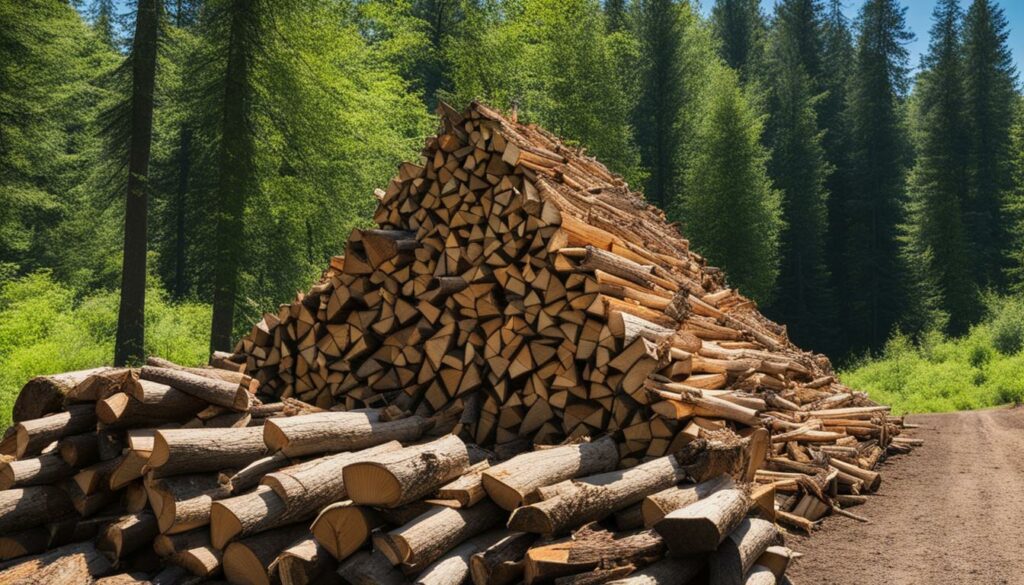
Gathering Firewood Checklist
- Locate dry, dead wood for tinder, kindling, and fuelwood.
- Ensure the firewood is free from moisture, mold, or insects.
- Avoid gathering firewood from live trees or fallen branches that are still green.
- Pack a small saw or axe for cutting larger branches if necessary.
- Collect more firewood than you think you’ll need to ensure a steady supply throughout the night.
“Choosing the right type of firewood and using proper fire pit techniques are essential for a safe and enjoyable camping experience.” – Camping Enthusiast
By prioritizing the gathering of proper firewood and following the guidelines provided by your camping site, you can ensure a successful campfire. Now that you have a good grasp of firewood essentials, let’s move on to Section 3: Choosing the Perfect Campfire Spot.
Camping Basics: Choosing the Perfect Campfire Spot
When it comes to camping, a campfire is an essential part of the experience. But before you can sit around the fire and enjoy its warmth, you need to choose the perfect campfire spot. Here are some tips to help you find the ideal location for your campfire.
1. Look for a flat area: It’s important to find a level and flat area to build your campfire. This ensures that your fire will stay contained and reduces the risk of it spreading. Avoid uneven ground or slopes, as they can cause the fire to become unstable.
2. Keep away from flammable vegetation: When selecting a campfire spot, make sure it is clear of any flammable vegetation. This includes dry grass, leaves, and branches. Select a spot that is surrounded by bare ground or rocks to minimize the risk of accidental fires spreading.
3. Maintain a safe distance: Your campfire should be at a safe distance from your tents, camping equipment, and any other flammable materials. Ensure there is enough space between your campfire and surrounding objects to prevent accidents and keep everyone safe.
Table: Campfire Safety Guidelines
| Guideline | Explanation |
|---|---|
| Flat Ground | Choose a flat area to prevent the fire from spreading. |
| No Flammable Vegetation | Avoid areas with dry grass, leaves, or branches. |
| Safe Distance | Keep a safe distance from tents and other flammable materials. |
By following these simple guidelines, you can ensure that your campfire is not only enjoyable but also safe. Remember to always prioritize safety when selecting a location for your campfire, and never leave it unattended. With the right campfire spot, you can create lasting memories and enjoy the magic of camping under the stars.
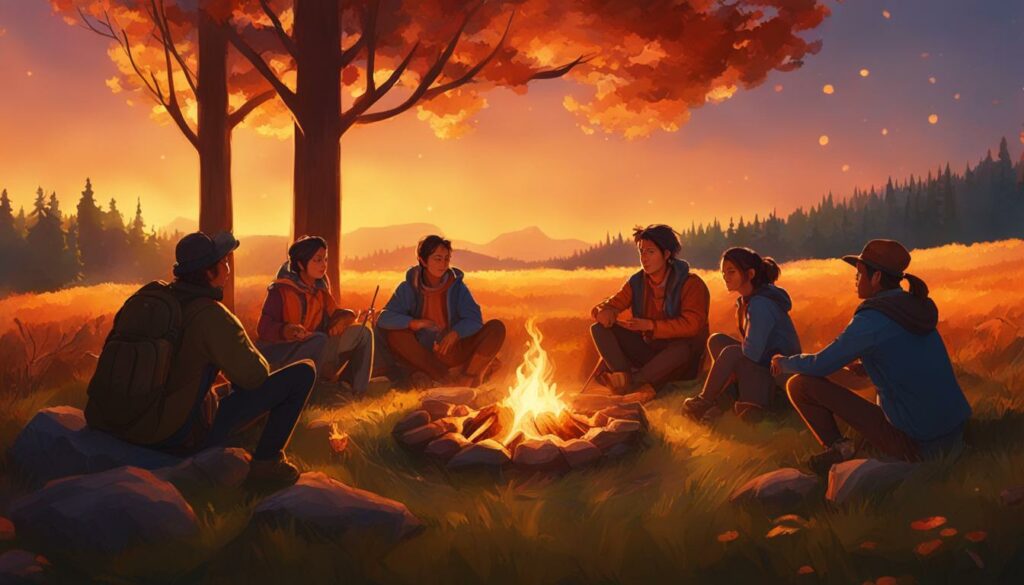
The Art of Building a Campfire
Building a campfire is an essential skill for any camping enthusiast. Whether you’re roasting marshmallows, cooking meals, or simply enjoying the warmth and ambiance, a well-built campfire can enhance your outdoor experience. Here, we’ll take you through the step-by-step process of building a campfire that will keep you cozy throughout the night.
To start, gather your firewood. Remember the key types: tinder, kindling, and fuelwood. Tinder consists of small, dry materials such as dry leaves, newspaper, or dry grass. Kindling is slightly larger and helps ignite the fuelwood. Finally, fuelwood refers to the larger pieces of wood that will sustain your fire.
Now that you have your firewood, it’s time to arrange it. Start by creating a small pile of tinder in the center of your fire pit or designated area. Then, carefully arrange the kindling in a teepee shape around the tinder, leaving enough space for air circulation. Light the tinder from multiple sides to ensure it catches fire evenly.
As the kindling starts to burn, gradually add fuelwood to the fire, keeping the teepee shape intact. This will allow the fire to grow slowly and steadily. Remember to never leave your campfire unattended and always have a water source nearby for safety.

Campfire building is truly an art. With practice and attention to detail, you’ll become a master of creating the perfect campfire. It’s a skill that will not only enhance your camping trips but also provide you with a sense of accomplishment and connection to the great outdoors. So, gather your firewood and get ready to embrace the magic of a crackling campfire under the stars.
Fire Tending 101: Taking Care of Your Campfire
Ensuring the safety and well-being of your campfire is essential during your camping trip. With proper fire tending, you can enjoy the warmth and ambiance of your campfire while minimizing the risk of accidents and environmental damage. Here are some camping safety tips and hacks for beginners to help you take care of your campfire.
Regular Monitoring and Maintenance
While your campfire doesn’t require constant attention, it’s important to regularly monitor and maintain it. Keep the fire at a moderate size, adding more firewood as needed to maintain a steady flame. Avoid letting the fire grow too large, as this can make it difficult to control and increase the risk of accidents. Additionally, regularly remove any debris or ashes from the fire pit to prevent them from smothering the flames.
Safe Distance and Surroundings
When tending to your campfire, always ensure that it is at a safe distance from tents, trees, and other flammable materials. Maintain a perimeter of at least 10 feet around the fire, free from any flammable vegetation. This will help prevent accidental fires and ensure the safety of everyone at the campsite. It’s also important to keep a bucket of water or a fire extinguisher nearby, just in case.
Extinguishing the Fire
When it’s time to extinguish your campfire, do it properly to prevent any reignition or spreading of embers. Start by pouring water over the fire, making sure to cover all the flames and embers. Use a shovel or stick to stir the ashes, ensuring that there are no hot spots remaining. Continue adding water and stirring until the fire site is cool to the touch. Remember, leaving a campfire unattended or improperly extinguished can have serious consequences, so always take the time to put it to bed.
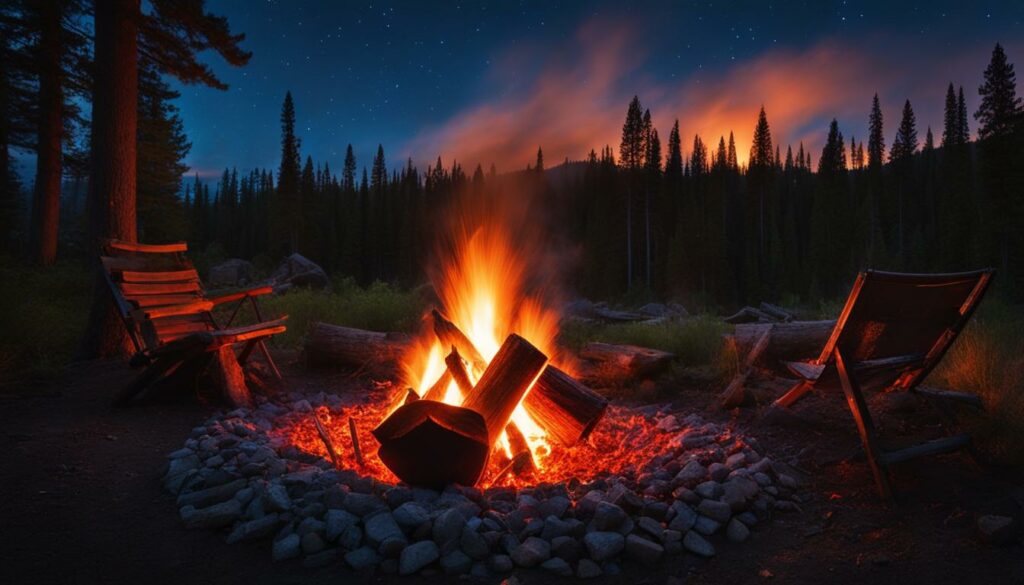
Campfire Safety: The Golden Rules
When it comes to camping, campfire safety is of utmost importance. By following a few golden rules, you can ensure a safe and enjoyable experience. We’ve compiled essential camping safety tips to help you stay prepared and minimize risks:
1. Never leave your campfire unattended:
It may seem obvious, but leaving a campfire unattended is a common mistake. Always ensure that someone is present and actively monitoring the fire. This helps prevent accidents and ensures that the fire remains under control.
2. Keep a water source or fire extinguisher nearby:
Accidents can happen, even with the best precautions. It’s crucial to have a water source or fire extinguisher within reach in case of emergencies. This allows you to quickly extinguish any unforeseen flare-ups or potential fire hazards.
3. Abide by fire bans and restrictions:
Before your camping trip, check for any fire bans or restrictions in the area. These regulations are in place to protect the environment and ensure everyone’s safety. Stay informed and comply with the rules to prevent wildfires and avoid penalties.
4. Properly extinguish your campfire:
When it’s time to put your campfire to bed, make sure you extinguish it properly. Gradually sprinkle water onto the fire, ensuring all embers and hot spots are thoroughly doused. Stir the ashes to expose any remaining heat and repeat the process until the fire is cool to the touch.
By following these golden rules, you can ensure a safe and responsible camping experience. Remember, campfire safety is everyone’s responsibility, so spread the word and share these tips with fellow campers.
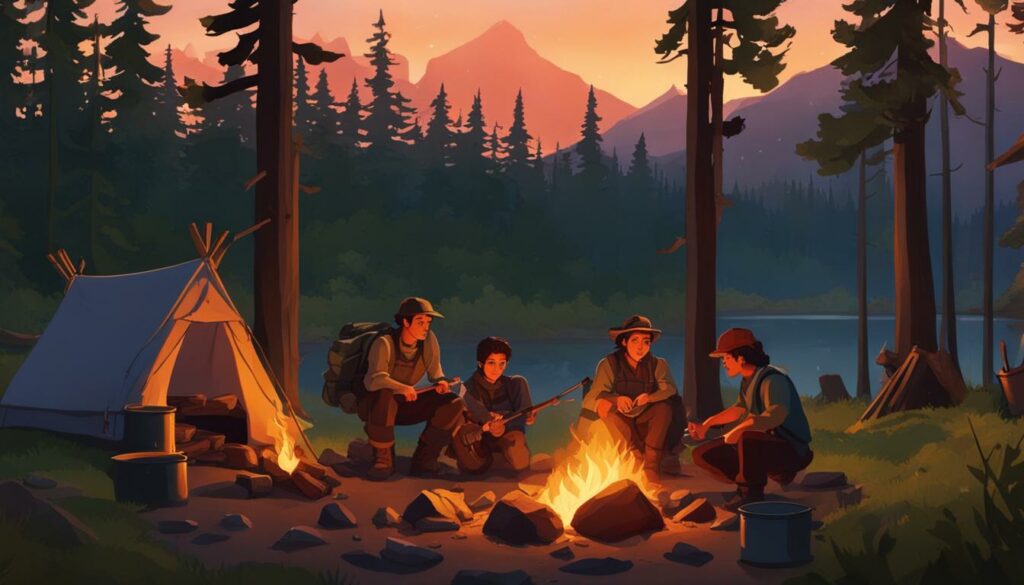
Camping Safety Tips: Ensuring a Secure and Enjoyable Experience
When it comes to camping, safety should always be a top priority. By following these camping safety tips, you’ll be able to enjoy your outdoor adventure while minimizing potential risks and hazards. Whether you’re a first-time camper or an experienced outdoor enthusiast, these guidelines will help keep you and your fellow campers safe and secure.
Fire Safety
- Always comply with fire bans and restrictions in your camping area. Check Stacked.camp for up-to-date information on any fire-related regulations.
- Choose a designated fire pit provided by the campground, or create a safe fire spot away from flammable materials.
- Keep a water source or fire extinguisher nearby at all times.
- Never leave your campfire unattended and ensure it is fully extinguished before leaving your campsite or going to bed.
Personal Safety
- Inform someone trustworthy about your camping plans, including your destination, expected return date, and emergency contact information.
- Stay aware of your surroundings and be cautious of wildlife encounters. Store food securely to prevent attracting animals to your campsite.
- Keep a first aid kit readily available and know basic first aid procedures.
- Carry a whistle or other signaling device in case of emergencies.
Weather and Equipment Safety
- Check weather forecasts before your trip and be prepared for changing weather conditions.
- Dress appropriately for the environment and bring sufficient layers to stay warm and dry.
- Inspect and test your camping gear before heading out to ensure it is in good working condition.
- Pitch your tent in a safe and sturdy location, away from potential hazards such as dead trees or rocky terrain.
By adhering to these camping safety tips, you can fully enjoy your outdoor experience while minimizing risks and ensuring the well-being of yourself and those around you. Remember, preparation and caution are key to a successful and memorable camping trip.
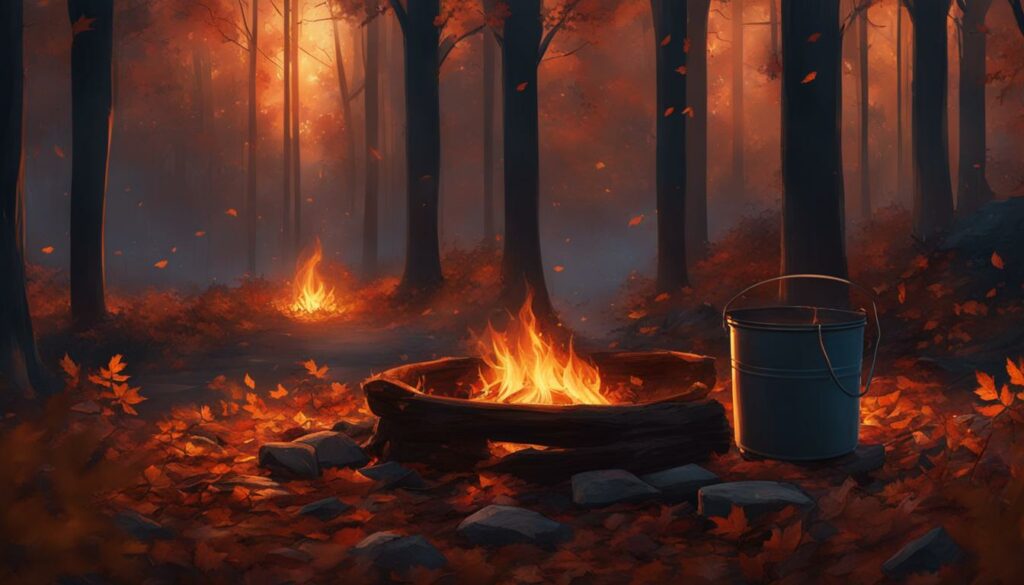
Canine Camping: Tips for Camping with Your Dog
Camping with your dog can be a rewarding and fun experience, but it requires some extra preparation to ensure their safety and well-being. Before embarking on your camping adventure, there are a few important factors to consider to make the trip enjoyable for both you and your furry companion.
Firstly, it’s essential to assess your dog’s temperament, energy level, and overall health. Not all dogs are suited for camping, especially those who are easily stressed or have health issues. Consult with your veterinarian to ensure your dog is up-to-date on vaccinations and protected against parasites.
Packing a dog-specific camping kit is crucial. This should include ample food and water, collapsible bowls, a leash, waste disposal bags, and any necessary medications. Additionally, consider bringing your dog’s favorite toys and treats to keep them entertained and relaxed during the trip.
When choosing a campsite, research dog-friendly campgrounds in advance. Check their policies regarding leashes, off-leash areas, and breed restrictions. It’s also important to consider the terrain and climate of the campground to ensure it suits your dog’s comfort level. Look for amenities such as nearby water sources and dog-friendly trails.
Throughout your camping trip, keep your dog hydrated and protected against parasites, insects, and wildlife. Always supervise your dog and ensure they are either on a leash or under voice control. It’s also wise to have a plan in place for emergencies and carry a basic first aid kit for pets.
Remember, camping with your dog can be a wonderful bonding experience, but it’s important to prioritize their safety and well-being. By following these tips, you’ll be well-prepared to embark on a camping adventure with your four-legged companion.
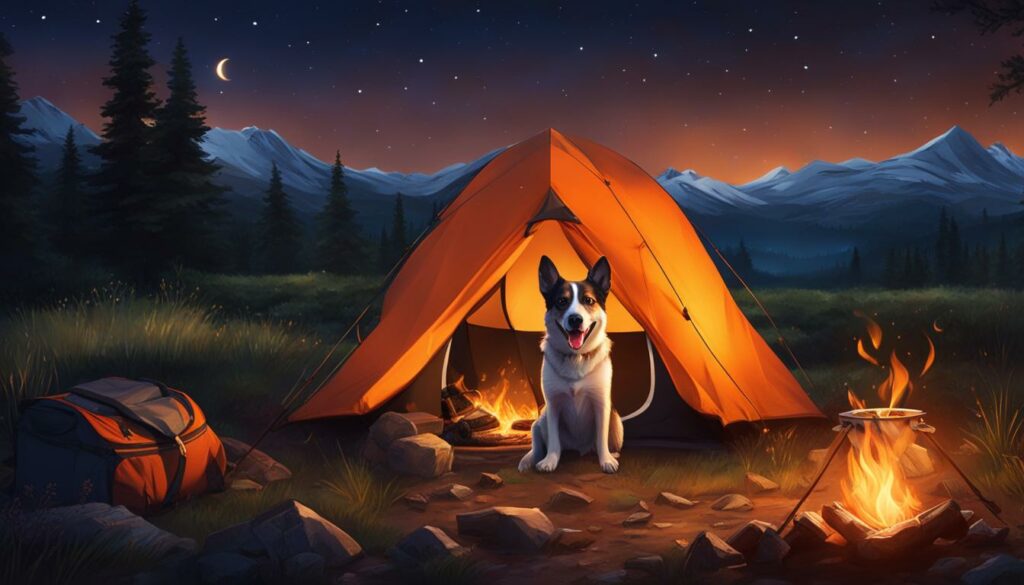
Preparing Your Dog for Camping Adventures
Before embarking on a camping trip with your furry companion, it’s essential to make sure your dog is prepared and ready for the adventure ahead. These tips will help you get your dog ready for a safe and enjoyable camping experience.
1. Visit the veterinarian
Prior to your camping trip, schedule a visit to your veterinarian for a check-up. Ensure that your dog is in good health and up-to-date on vaccinations, flea, and tick prevention. Discuss any specific concerns or considerations with your vet, such as allergies or dietary needs.
2. Pack a dog-specific camping kit
Put together a camping kit specifically for your dog. Include ample food and water for the duration of the trip, as well as any necessary medications or supplements. Don’t forget to pack bowls for food and water, a leash and collar, waste disposal bags, and bedding for your dog’s comfort.

3. Introduce your dog to camping equipment
Set up camping equipment, such as a tent or sleeping bag, in your backyard or living space before the trip. Allow your dog to familiarize themselves with these items and spend time in them. This will help reduce any anxiety or stress they may experience when encountering these new surroundings at the campground.
4. Train your dog in basic obedience commands
Basic obedience training is crucial for camping with your dog. Make sure your dog responds to commands like “sit,” “stay,” and “come.” These commands will help keep your dog safe and under control while exploring the campsite and surrounding areas. Consider enrolling in a training class if your dog needs some extra guidance.

5. Prepare your dog for the outdoors
Expose your dog to the sights, sounds, and smells of the outdoors before your camping trip. Take them for walks in parks or nature reserves to get them accustomed to wildlife, other dogs, and various environments. This will help them feel more comfortable and relaxed during the camping adventure.
By following these tips, you’ll ensure that your dog is well-prepared for a fantastic camping experience. Remember to always prioritize your dog’s safety and well-being, and enjoy the wonders of the great outdoors together!
Camping with Your Dog: Choosing the Right Campsite
When planning a camping trip with your furry friend, it’s important to choose the right campsite that suits both your needs. Here are some factors to consider:
- Leash and off-leash policies: Check if the campground allows dogs off-leash or if there are designated areas where they can roam freely.
- Breed restrictions: Some campgrounds may have restrictions on certain breeds, so be sure to check their pet policies.
- Terrain and climate: Consider the terrain and climate of the campground. If your dog is not comfortable with rugged terrain or extreme temperatures, opt for a campsite that offers more suitable conditions.
- Amenities: Look for campgrounds with amenities such as nearby water sources for your dog to cool off and dog-friendly trails for enjoyable walks.
Researching dog-friendly campgrounds in advance will ensure that you find the perfect spot where both you and your four-legged companion can have a fantastic time.
“Choosing the right campsite is essential for a successful camping trip with your dog. It sets the stage for a safe and enjoyable experience for both you and your furry friend.”
Table: Campsite Comparison
| Campground | Leash Policy | Breed Restrictions | Terrain | Climate | Amenities |
|---|---|---|---|---|---|
| Wilderness Retreat | Off-leash allowed in designated areas | No breed restrictions | Rugged trails and hills | Mild temperatures | Water access, dog-friendly trails |
| Pine Valley Campground | Dogs must be leashed at all times | No breed restrictions | Gentle terrain, grassy areas | Moderate temperatures | Nearby river, pet-friendly cabins |
| Mountain Vista Campsite | Dogs must be leashed at all times | Breed restrictions on aggressive breeds | Steep trails, rocky terrain | Cool mountain climate | Dog park, hiking trails |
By considering these factors and utilizing the campsite comparison table, you’ll be able to select a campground that provides a safe and enjoyable environment for you and your beloved canine companion to create wonderful camping memories together.
Essential Gear for Camping with Your Dog
When embarking on a camping adventure with your furry companion, it’s important to have the right gear to ensure their comfort and safety. Here are some essential items to include in your camping checklist:
Dog-Friendly Sleeping Arrangement:
Provide your dog with a cozy and secure place to sleep. Consider a camping-specific dog bed or a portable pet tent to give them their own space. If your dog is comfortable in a crate, bring it along to provide a familiar sleeping environment.
Leashes and Collars:
Always have a sturdy leash and collar on hand to keep your dog safely by your side. Choose a leash that allows for freedom of movement while still maintaining control. Remember to attach identification tags with your contact information in case your dog gets lost.
Portable Water Bowls:
Keep your dog hydrated during your camping trip by packing collapsible water bowls. These lightweight and compact bowls are easy to carry and can be filled up whenever your dog needs a drink. Ensure you have enough water for both you and your canine companion.
“Having the right gear for your dog can make a world of difference during your camping trip. It ensures their comfort, safety, and overall enjoyment of the experience.”
Waste Disposal Bags:
Responsible pet ownership includes picking up after your dog. Pack plenty of waste disposal bags to clean up after them during your camping trip. These bags are essential for maintaining a clean and sanitary campsite.
Doggie First Aid Kit:
Accidents can happen even during the most enjoyable adventures. Be prepared by bringing a doggie first aid kit that includes items such as bandages, antiseptic wipes, tweezers, and any necessary medications. Familiarize yourself with basic pet first aid procedures, and consult your veterinarian for specific recommendations.
By packing these essential gear items, you’ll be well-prepared to provide a safe and comfortable camping experience for your dog. Remember to tailor your gear to your dog’s specific needs, and always prioritize their well-being throughout your outdoor adventures.
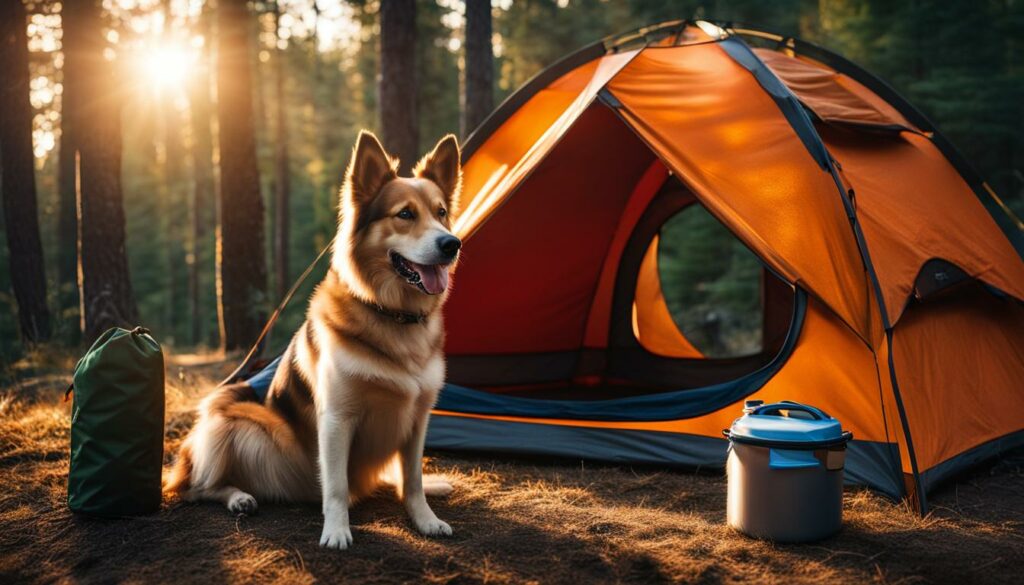
Outdoor Adventures with Your Four-Legged Companion
Exploring the great outdoors with your four-legged companion is a wonderful way to bond and enjoy a range of activities together. Whether you’re hiking through picturesque trails or relaxing on a dog-friendly beach, outdoor adventures provide opportunities for both physical exercise and mental stimulation for your furry friend.
“Being out in nature with our dogs allows us to experience the beauty of our surroundings while strengthening the bond we share. It’s a win-win situation for both us and our pets,” says Dr. Sarah Thompson, a veterinarian and outdoor enthusiast.
When embarking on outdoor adventures with your dog, it’s important to consider their fitness level and capabilities. Start with shorter hikes or walks and gradually increase the duration and difficulty of the activities as your dog becomes more comfortable and confident. Remember to always bring plenty of water for both you and your dog, as staying hydrated is essential for a safe and enjoyable adventure.
Additionally, be mindful of the terrain and weather conditions while planning your outdoor activities. Steep and rocky trails may not be suitable for dogs with joint issues or older dogs, while extreme heat or cold can be detrimental to their well-being. It’s crucial to prioritize your dog’s comfort and safety at all times.
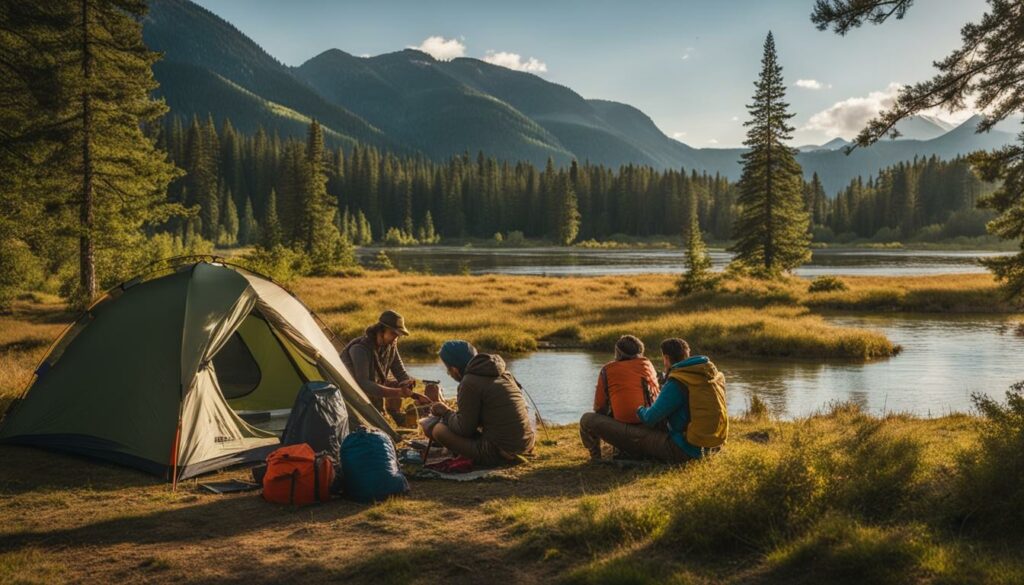
Take advantage of the various outdoor activities available for you and your four-legged companion. Besides hiking, you can engage in activities such as swimming, playing fetch, or even practicing obedience training in an open park. These activities not only provide exercise but also mental stimulation, keeping your dog happy and engaged.
Remember to always follow local regulations regarding leash requirements and clean up after your dog to maintain the cleanliness and safety of outdoor spaces. By being responsible pet owners and respecting nature, we can continue to enjoy outdoor adventures with our beloved dogs for years to come.
Keeping Your Dog Safe during the Camping Trip
When taking your furry companion on a camping trip, their safety should be a top priority. By following a few camping safety tips and hacks, you can ensure that both you and your dog have a fantastic and worry-free outdoor adventure.
Prioritize Hydration and Protection
During your camping trip, it’s crucial to keep your dog hydrated at all times. Bring plenty of fresh water and a portable bowl for your dog to drink from. Remember to refill their water bowl regularly to prevent dehydration.
Additionally, protect your dog against parasites, insects, and wildlife. Apply a dog-friendly insect repellent to keep mosquitoes and ticks at bay. Check your dog for ticks regularly and remove any you find. Keep your dog on a leash or under voice control to prevent them from encountering wildlife that may pose a danger.
Supervise and Control Your Dog
While camping, it’s important to supervise your dog at all times. Keep them within your sight to ensure their safety and prevent them from wandering off into potentially dangerous areas. If your dog is off-leash, make sure they respond reliably to voice commands.
Be Prepared for Emergencies
Have a plan in place for emergencies and carry a basic first aid kit for pets. The kit should include items such as bandages, tweezers for removing splinters or ticks, and any necessary medications. Familiarize yourself with the nearest veterinary clinic or emergency animal hospital in case of any major incidents.
By following these camping safety tips and hacks, you can provide a safe and enjoyable experience for both you and your dog. Remember, preparation and vigilance are key to ensuring a successful camping trip with your four-legged companion.
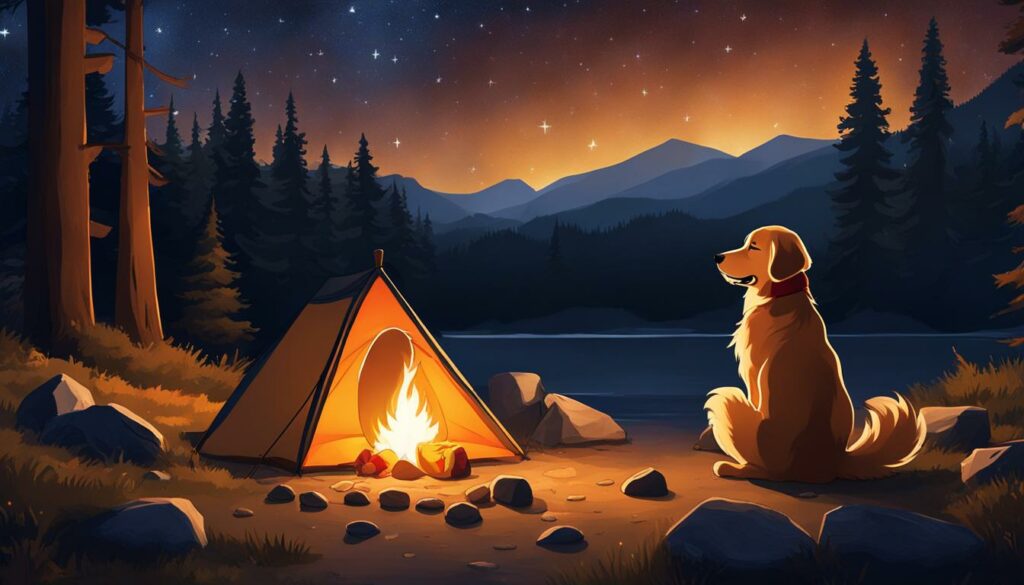
Conclusion
Camping can be a fulfilling and exciting experience for beginners and their furry companions. By following this guide, you’ll be well-prepared to embark on your camping adventure, create lasting memories, and develop a greater appreciation for the great outdoors.
Remember to prioritize safety by choosing the right campsite, building and tending to your campfire responsibly, and keeping a water source or fire extinguisher nearby. Respect nature by adhering to fire bans and restrictions, properly extinguishing your campfire, and leaving no trace. Most importantly, have fun exploring the beauty of the natural world and enjoying quality time with your loved ones.
Whether you’re a novice camper or have some experience under your belt, this beginner’s guide will equip you with the knowledge and confidence to make the most of your camping trips. So gear up, gather your essentials, and get ready to embark on unforgettable adventures in the great outdoors. Happy camping!
FAQ
What types of firewood do I need for a campfire?
You’ll need tinder, kindling, and fuelwood for a successful campfire.
How can I find local sources of firewood for camping?
You can use websites like Stacked.camp to find local sources of firewood in your camping area.
Should I use the fire pit provided by the campground?
Yes, using a fire pit provided by the campground is important for safety and environmental protection.
What should I consider when choosing a campfire spot?
Make sure the spot is flat, away from flammable vegetation, and at a safe distance from tents and other flammable materials.
How can I build a campfire?
Start with tinder, add kindling, and arrange fuelwood in a teepee structure.
How should I tend to my campfire?
Regularly monitor the fire, keep it at a moderate size, and add more firewood as needed.
What precautions should I take for campfire safety?
Never leave your campfire unattended, keep a water source or fire extinguisher nearby, and abide by fire bans and restrictions in your camping area.
How do I properly extinguish a campfire?
Sprinkle water onto the fire gradually, stir the ashes and embers, and only leave the fire site when it is cool to the touch.
How can I prepare my dog for camping?
Consider your dog’s temperament, energy level, and health, ensure they are up-to-date on vaccinations, and pack a dog-specific camping kit.
What should I pack for camping with my dog?
Pack essential gear such as a dog-friendly sleeping arrangement, leashes, collars, portable water bowls, waste disposal bags, and a doggie first aid kit.
Can I let my dog off-leash while camping?
Check the policies of the campground regarding leashes, off-leash areas, and breed restrictions and always supervise your dog.
How can I keep my dog safe during the camping trip?
Keep your dog hydrated, protected against parasites, insects, and wildlife, and have a plan for emergencies.

